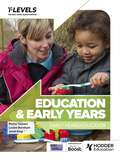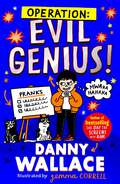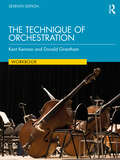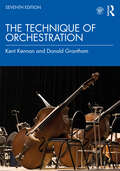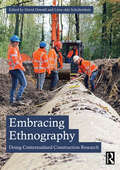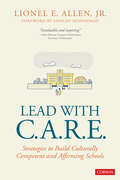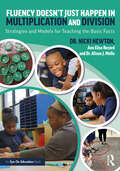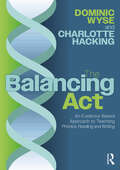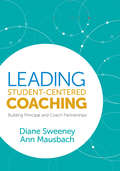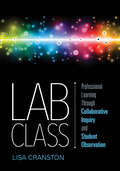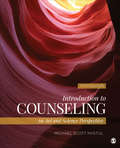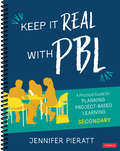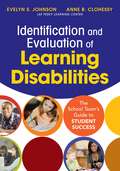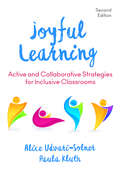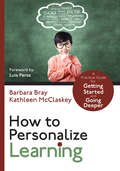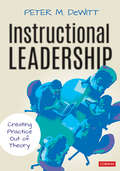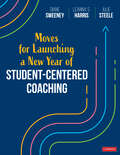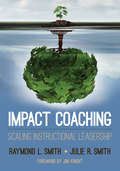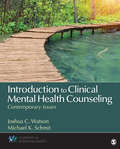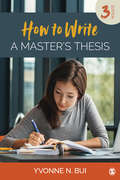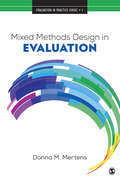- Table View
- List View
Education and Early Years T Level: Early Years Educator
by Penny Tassoni Louise Burnham Janet KingBegin your path to a career in Education and Early Years with this T Level textbook that covers both the core content and the early years educator specialism content you will need to understand to be successful in your qualification. For first teaching from September 2023.Develop your understanding of the key principles, concepts, theories and skills that will give you a solid foundation of knowledge to support you during your industry placement.Created in partnership with NCFE and written by highly respected authors Penny Tassoni, Louise Burnham and Janet King, you can feel confident relying on the insights and experience of these experts.- Track and consolidate your learning using the learning outcomes at the beginning of every unit and Test Yourself questions throughout each unit- Ensure you don't miss any important terminology with key terms highlighted and defined in context- Contextualise your learning with case studies, reflection tasks and practice points- Prepare for your examinations with knowledge-based practice questions- Understand how to approach your assignments with practical tasks and model answers
Operation: Evil Genius
by Danny Wallace*PRE-ORDER NOW* What would you do if you woke up one day to find that your best friend has become your worst enemy?That's exactly what happens to 11-year-old Ryan in this brand-new comedy adventure from bestselling author, comedian, and presenter Danny Wallace, perfect for readers age 8+ and fans of Stephen Mangan, Andy Griffiths, Jenny Pearson, Helen Rutter, David Walliams and David Baddiel. Separated only by a garden fence, Ryan and Tom have been best friends since they were two years old. But while Ryan is looking forward to starting secondary school together, Tom doesn't seem to want anything to do him with anymore. Suddenly, he&’d rather hang out with mean Minnie and horrible Simon! Ryan sets out to repair their friendship . . . but everything he tries backfires spectacularly. So Ryan decides that there&’s only one thing for it – he must exact terrible revenge on his ex-best friend. Cue: Operation Evil Genius. There&’s only one problem… every time Ryan tries to make Tom look BAD, he ends up looking GOOD. As it turns out, Ryan is terrible at being terrible! Don&’t miss this hilarious and heart-warming comedy adventure about the magic of true friendship from the bestselling author of The Day the Screens Went Blank. Fully illustrated throughout by Gemma Correll. From the author of highly acclaimed adult bestsellers YES MAN, JOIN ME and the eagerly anticipated SOMEBODY TOLD ME.Other books by Danny Wallace:The Boss of Everyone The Luckiest Kid in the World The Day the Screens Went Blank Hamish and the Worldstoppers Hamish and the Neverpeople Hamish and the Gravity Burp Hamish and the Baby Boom Hamish and the Terrible Terrible Christmas and Other Stories Hamish and the Monster PatrolPraise for The Day the Screens Went Blank: 'So funny' Noel Fielding 'Brilliantly funny' Shappi Khorsandi 'Hilarious' Tim Minchin 'Warm and funny' Frank Cottrell-Boyce
The Technique of Orchestration Workbook
by Kent Kennan Donald GranthamThe Technique of Orchestration Workbook, Seventh Edition, accompanies the textbook of the same name—the definitive resource on the study of orchestration—providing musical excerpts, full scores, and scoring assignments to enrich the lessons learned in the textbook. Spanning an array of periods and styles, the musical examples collected here cover scoring techniques in the following sections: Strings Woodwinds Brass Scoring of Chords Transcribing Piano Music Scoring for Woodwinds, Horns, and Strings Percussion Harp and Keyboard Instruments Scoring for Full Orchestra Additional learning tools include transposition exercises, error detection drills, and discussions on harmonics, while the workbook pages are perforated throughout for ease of use in and out of the classroom. Featuring the music of Bach, Mozart, Brahms, Beethoven, Schumann, Copland, Bartók, and many more, The Technique of Orchestration Workbook, Seventh Edition, is an invaluable companion to the textbook.
The Technique of Orchestration: Pearson New International Edition
by Kent Kennan Donald GranthamThe Technique of Orchestration, Seventh Edition, is the definitive textbook on the study of orchestration, offering a concise, straight-to-the-point approach that prepares students to score their own compositions with confidence. Updated to reflect developments in instruments and orchestral best practices, this seventh edition features: Copious musical examples spanning the history of the orchestra Detailed descriptions of instruments and their distinctive characteristics Explanations of how to score chords and transcribe piano idioms Discussions on specialized ensembles and scoring techniques New musical examples have been added throughout and listening lists have been revised to include more music by women and composers of color, representing a diverse musical catalogue. Supported by an accompanying workbook of scores and scoring exercises (available separately), as well as a robust listening program keyed to the textbook, The Technique of Orchestration, Seventh Edition, is an accessible, essential, all-in-one resource for the student of orchestration.
Embracing Ethnography: Doing Contextualised Construction Research
by David Oswald Léon Olde ScholtenhuisThis book calls for those interested in robust construction research to embrace ethnography – in all its forms, including rapid ethnographies, ethnographic-action research, autoethnography, as well as longer-term ethnographies.The diversification of ethnographic approaches, as well as ethnographers, will lead to rich insights that can advance the industry theoretically and practically. We share experiences, key considerations and recommendations from leading construction ethnographic researchers from around the world to provide discussion, reflection and understanding into doing ethnography in the construction industry.This book is aimed at academics, students, consultants, editors, reviewers, policymakers, funders and others interested in robust research in the construction industry and built environment but will also be useful for those undertaking research within organisations in other industries.
Lead With C.A.R.E.: Strategies to Build Culturally Competent and Affirming Schools
by Lionel E. AllenA framework for the courageous school leadership our students deserve. From the foreword by Gholdy Muhammad… "In Leading With C.A.R.E., Dr. Allen provides a way to disrupt the harms that systems, teachers, and leaders may inflict on children. He uses the richness of his personal and professional experiences to speak to the true purpose and power of schools, which is to disrupt disparities and affirm students’ cultural identities and brilliance. In doing so, Dr. Allen reminds educators that we must examine the structures of education historically and in the present so that we can dismantle harmful practices. The framework of C.A.R.E. presented here guides educators to lead with Culturally Responsiveness in teaching and learning, while Affirming children’s identities, and building positive Relationships with youth. Dr. Allen posits that this leads to spaces of Empowerment. This book provides the what, the why and importantly, the how. The C.A.R.E. framework helps leaders center the genius and joy of youth and teachers, while recognizing the social times we live in and elevating the education of children, especially those who have been historically excluded in schooling and in society. The framework provides a way forward for leaders to lead differently—with care, belonging, and excellence; providing every child with what they deeply deserve." With learning goals, summaries, and reflection questions included in each chapter, this guide offers actionable strategies educators can use to establish a culture that prioritizes students’ experiences and affirms their identities.
Lead With C.A.R.E.: Strategies to Build Culturally Competent and Affirming Schools
by Lionel E. AllenA framework for the courageous school leadership our students deserve. From the foreword by Gholdy Muhammad… "In Leading With C.A.R.E., Dr. Allen provides a way to disrupt the harms that systems, teachers, and leaders may inflict on children. He uses the richness of his personal and professional experiences to speak to the true purpose and power of schools, which is to disrupt disparities and affirm students’ cultural identities and brilliance. In doing so, Dr. Allen reminds educators that we must examine the structures of education historically and in the present so that we can dismantle harmful practices. The framework of C.A.R.E. presented here guides educators to lead with Culturally Responsiveness in teaching and learning, while Affirming children’s identities, and building positive Relationships with youth. Dr. Allen posits that this leads to spaces of Empowerment. This book provides the what, the why and importantly, the how. The C.A.R.E. framework helps leaders center the genius and joy of youth and teachers, while recognizing the social times we live in and elevating the education of children, especially those who have been historically excluded in schooling and in society. The framework provides a way forward for leaders to lead differently—with care, belonging, and excellence; providing every child with what they deeply deserve." With learning goals, summaries, and reflection questions included in each chapter, this guide offers actionable strategies educators can use to establish a culture that prioritizes students’ experiences and affirms their identities.
Fluency Doesn't Just Happen in Multiplication and Division: Strategies and Models for Teaching the Basic Facts
by Nicki Newton Ann Elise Record Alison J. MelloFluency in math doesn’t just happen; it is a well-planned journey. In this book, you’ll find practical strategies and activities for teaching your elementary students basic multiplication and division.The authors lay out the basic framework for building math fluency using a cycle of engagement (concrete, pictorial, abstract) and provide a multitude of examples illustrating the strategies in action. You’ll learn how to help students to model their thinking with a variety of tools; keep students engaged through games, poems, songs, and technology; assess student development to facilitate active and continuous learning; implement distributed practices throughout the year; and boost parental involvement so that students remain encouraged even as material becomes more complex.A final chapter devoted to action plans will help you put these strategies into practice in your classroom right away. Most importantly, you’ll open the door to deep and lasting math fluency.
The Balancing Act: An Evidence-Based Approach to Teaching Phonics, Reading and Writing
by Dominic Wyse Charlotte HackingDominic Wyse and Charlotte Hacking present a ground-breaking account of teaching phonics, reading, and writing. Created from a landmark study, new research, new theory, and cutting-edge teacher professional development, this balanced approach to teaching seeks to improve all children’s learning, and therefore life chances.The book dismantles polarised debates about the teaching of phonics and analyses the latest scientific evidence of what really works. It shows, in vivid detail, how phonics, reading, and writing should be taught through the creativity of some of the best authors of books for children. By describing lessons inspired by ‘real books’, it showcases why the new approach is more effective than narrow phonics approaches.The authors call for a paradigm shift in literacy education. The chapters show how and why education policies should be improved on the basis of unique analyses of research evidence from experimental trials and the new theory and model the Double Helix of Reading and Writing. It is a book of hope for the future in the context of powerful elites influencing narrow curricula, narrow pedagogy, and high stakes assessments.The Balancing Act will be of interest to anyone who is invested in young children’s development. It is essential reading for teachers, trainee teachers, lecturers, researchers, and policy makers world-wide who want to improve the teaching of reading and writing in the English language.
Leading Student-Centered Coaching: Building Principal and Coach Partnerships
by Diane Sweeney Ann MausbachEssential leadership moves for supporting instructional coaching in your school Strong leadership is essential in any successful instructional coaching effort. Leading Student-Centered Coaching provides principals and district leaders with the background, practices, and tools required for leading coaching efforts that have a profound and positive impact on student and teacher learning. Filled with practical ideas that school leaders can easily apply to their own school settings, this book includes: Tools and techniques for preparing a school for coaching, launching a coaching culture, and supporting coaches Leadership Moves sections that provide strategies for building principal and coach partnerships Richly detailed Lessons from the Field, based on the authors’ real-life experiences, that illustrate principal and coach collaboration Recommendations for coaches to use as they strive to increase their impact With a focus on the critical role of school leadership, this action-oriented guide provides the key ingredients for ensuring the success of school-based coaching initiatives. "Sweeney and Mausbach explore the necessary ingredients to a successful instructional coach partnership between the principal and the coaches. This is a must-read for building leadership teams implementing an instructional coach program" —Timothy S. Grieves, Chief Administrator Northwest Area Education Agency, IA "This book synthesized the work necessary of school leaders when working with the coach. As a principal who was a student-centered coach, this book has shown me how I can tweak the skills I learned and apply them with a leadership lens." —Kelly Neylon, Principal Meadowview School, Woodridge IL
Lab Class: Professional Learning Through Collaborative Inquiry and Student Observation
by Lisa Ann CranstonSchool-based, collaborative teacher learning that drives student achievement Meaningful growth in teacher practice comes when we invest in teacher-led, inquiry-based collaborative models where teachers get to roll up their sleeves and study what’s really going on in classrooms. Lab Class introduces an observation-based professional learning design that helps teachers collaboratively plan, investigate, and develop solutions to a specific problem of practice by observing a host teacher’s classroom through the eyes of students. This book provides instructional leaders and team facilitators with observation protocols that encourage teachers to: Plan collaborative inquiry projects by identifying a focus of the inquiry, combing the research literature, creating norms for observations, and identifying resources needed Observe and analyze student conversations, actions, and products to determine the impact of instructional decisions on students Identify patterns from observations and determine next steps for professional learning Close the knowing-doing gap by bringing professional learning out of workshops and back where it belongs—in the classroom! "For those looking to empower teachers by bringing the learning of teaching closer to the classroom, this resource will help you achieve your goals." —Jenni Donohoo, Provincial Literacy Lead, Council of Ontario Directors of Education Author of Collective Efficacy "Lab Class is a professional learning structure to take learning walks to the next level. It provides a process to deepen inquiry and focus teacher observations and learning." —Ellen S. Perconti, Superintendent Mary M. Knight School District, WA
Introduction to Counseling: An Art and Science Perspective
by Michael S. NystulIntroduction to Counseling provides an overview of counseling and the helping professions from the perspective of art and science—the science of counseling that generates a knowledge base proven to promote competency and efficacy in the practitioner, and the art of using this knowledge base to build skills that can be applied sensitively to clients in a multicultural society. The Fifth Edition has been organized into three sections: (1) an overview of counseling and the counseling process, (2) multicultural counseling and counseling theories, and (3) special approaches and settings. It continues to address key topics and issues, including gender, culture, and sexual orientation, and offers ways to integrate multiculturalism into all aspects of counseling, rather than view it as a separate entity. Highlighting emerging trends and changes in ethical codes, as well as reflecting the latest updates to the Diagnostic Statistical Manual (DSM-5), the book successfully illustrates the importance of art and science to modern-day counseling.
Keep It Real With PBL, Secondary: A Practical Guide for Planning Project-Based Learning (Corwin Teaching Essentials)
by Jennifer R. PierattLet′s Get Real About PBL The book′s companion website features an updated guide to help teachers integrate technology into PBL experiences for online and blended learning instruction. Does project-based learning (PBL) feel just out of reach in in your secondary classroom? Is project-planning an overwhelming project in and of itself? Dr. Jennifer Pieratt, a consultant and former teacher, knows firsthand how challenging designing projects can be, especially for secondary teachers with large caseloads and short class periods to engage in meaningful teaching and learning. In this hands-on, interactive guide, Pieratt supports secondary teachers through the iterative process of planning authentic project-based learning experiences. Using backward design, she gives teachers ready to use strategies for identifying the best concepts to tackle in PBL experiences, brainstorming realistic projects, facilitating meaningful learning, and creating formative and summative assessments. The book is visually accessible in style and features #realtalk soundbites that tackle the challenges to implementing PBL Tips and resources to support the project-planning process Planning forms to guide you through planning your projects Key terminology and acronyms in PBL Exercises to help you reflect and process throughout your project plans Master PBL planning with this clear, efficient, and easy-to-use guide to creating enriching experiences for your students!
Keep It Real With PBL, Secondary: A Practical Guide for Planning Project-Based Learning (Corwin Teaching Essentials)
by Jennifer R. PierattLet′s Get Real About PBL The book′s companion website features an updated guide to help teachers integrate technology into PBL experiences for online and blended learning instruction. Does project-based learning (PBL) feel just out of reach in in your secondary classroom? Is project-planning an overwhelming project in and of itself? Dr. Jennifer Pieratt, a consultant and former teacher, knows firsthand how challenging designing projects can be, especially for secondary teachers with large caseloads and short class periods to engage in meaningful teaching and learning. In this hands-on, interactive guide, Pieratt supports secondary teachers through the iterative process of planning authentic project-based learning experiences. Using backward design, she gives teachers ready to use strategies for identifying the best concepts to tackle in PBL experiences, brainstorming realistic projects, facilitating meaningful learning, and creating formative and summative assessments. The book is visually accessible in style and features #realtalk soundbites that tackle the challenges to implementing PBL Tips and resources to support the project-planning process Planning forms to guide you through planning your projects Key terminology and acronyms in PBL Exercises to help you reflect and process throughout your project plans Master PBL planning with this clear, efficient, and easy-to-use guide to creating enriching experiences for your students!
Identification and Evaluation of Learning Disabilities: The School Team’s Guide to Student Success
by Evelyn S. Johnson Anne B. ClohessyEnsure that your students have the support they need! When it comes to designing instruction for students with learning disabilities, one size does not fit all — and that’s also true for identifying and evaluating learning disabilities. Theories and legislation aside, it’s critical for your school team to have a comprehensive plan to make sure every child gets the right kind of attention—and no one falls through the cracks. This compelling, easy-to-use handbook guides general educators, special educators, administrators, and school psychologists through the eligibility and evaluation stages to ensure that students get the best services and interventions they need to be successful. You’ll find: Guidance on what data to collect and how to collect it Strategies for combining RTI with a comprehensive evaluation to diagnose SLD Detailed case studies—with graphs, figures, and test scores—at the school, classroom, and individual student level Everyone on your team has the same goal: to help students with learning challenges achieve success. This comprehensive resource has the tools you need to make that happen. "This book reminds educators that we are responsible for all of our students. When students are not making the progress we expect, this text offers very specific, practical suggestions that educators can follow. This book helps to identify if a student has a specific learning disability and offers suggestions for addressing the student’s difficulty through a team approach. When using the case studies, teachers will see many examples related to their own students and find new resources to try in their classrooms that will assist those who are having difficulty making significant progress." —Marcia B. Imbeau, Professor University of Arkansas
Identification and Evaluation of Learning Disabilities: The School Team’s Guide to Student Success
by Evelyn S. Johnson Anne B. ClohessyEnsure that your students have the support they need! When it comes to designing instruction for students with learning disabilities, one size does not fit all — and that’s also true for identifying and evaluating learning disabilities. Theories and legislation aside, it’s critical for your school team to have a comprehensive plan to make sure every child gets the right kind of attention—and no one falls through the cracks. This compelling, easy-to-use handbook guides general educators, special educators, administrators, and school psychologists through the eligibility and evaluation stages to ensure that students get the best services and interventions they need to be successful. You’ll find: Guidance on what data to collect and how to collect it Strategies for combining RTI with a comprehensive evaluation to diagnose SLD Detailed case studies—with graphs, figures, and test scores—at the school, classroom, and individual student level Everyone on your team has the same goal: to help students with learning challenges achieve success. This comprehensive resource has the tools you need to make that happen. "This book reminds educators that we are responsible for all of our students. When students are not making the progress we expect, this text offers very specific, practical suggestions that educators can follow. This book helps to identify if a student has a specific learning disability and offers suggestions for addressing the student’s difficulty through a team approach. When using the case studies, teachers will see many examples related to their own students and find new resources to try in their classrooms that will assist those who are having difficulty making significant progress." —Marcia B. Imbeau, Professor University of Arkansas
Joyful Learning: Active and Collaborative Strategies for Inclusive Classrooms
by Alice Udvari-Solner Paula M. KluthDiscover motivating, personalized learning strategies that all of your students will love! Build an active, responsive, and inclusive classroom where every student benefits. Through step-by-step directions, reproducible handouts, classroom-tested examples, and specific guidelines, teachers and teacher teams will discover 60 activities to help you: Quickly and easily modify and adapt design instruction for diverse learners, including students with cultural, language, learning, physical, or sensory differences Transform lectures and whole-class discussions through dynamic, student-centered learning experiences Immerse students in discussion, debate, creative thinking, questioning, teamwork, and collaborative learning Flexibly co-plan and co-teach with a variety of school professionals The revised edition of this bestselling resource includes step-by-step directions, reproducible handouts, classroom-tested examples, and specific guidelines. Discover quick and easy ways to help all learners participate, contribute, and learn with this unique guide! "This book is a gold mine of strategies to increase engagement, participation, and JOY for all students in inclusive classrooms. The examples and implementation suggestions make is easy for K-12 teachers to select and apply strategies that make learning meaningful and fun." —Barb Gruber, Inclusion Facilitator Maryland Coalition for Inclusive Education "One of the many things I appreciate about this new edition is the range of its examples. Regardless of grade level or subject area, all K-12 teachers will find relevant gems here." —Kelly Chandler-Olcott, Associate Dean for Research Syracuse University
How to Personalize Learning: A Practical Guide for Getting Started and Going Deeper (Corwin Teaching Essentials)
by Barbara A. Bray Kathleen A. McClaskeyHOW to Personalize Learning This practical follow-up to Bray and McClaskey’s first book, Make Learning Personal: The What, Who, Wow, Where, and Whybrings theory to practice. Teachers will find the tools, skills, and strategies needed to personalize learning and develop self-directed, independent learners with agency. Discover how to get started and go deeper by building a shared vision that supports personalized learning using the Universal Design for Learning (UDL) framework. Also included are: Tools and templates such as the Learner Profile, Personal Learning Backpack, Personal Learning Plan, as well as tips for lesson design and PBL Lesson and project examples that show how teachers can change instructional practice by encouraging learner voice and choice QR codes and links to the authors’ website for electronic versions of tools, templates, activities, and checklists Create a powerful shift in education by building a culture of learning so every learner is valued. "If you are looking for a step-by-step guide on what personalized learning is and how to implement it, while being inspired and gaining ideas to implement immediately, this is definitely the book to read!" Diana Petschauer, Assistive Technology Professional, CEO AT for Education & Access4Employment, Wolfeboro Falls, NH "Barbara and Kathleen present well-tested strategies for personalization within a coherent framework. This highly practical book forms a reliable foundation for empowering a community striving to make schools work for all learners." John H. Clarke, Professor Emeritus, University of Vermont
Instructional Leadership: Creating Practice Out of Theory
by Peter M. DeWittBridge the gap between good intentions and real results Instructional Leadership is one of the most researched and discussed leadership practices, but most school leaders don’t know where to begin or how to balance this role with all of their other responsibilities. Peter DeWitt’s Instructional Leadership provides practical tools for delivering lasting improvement through small, manageable changes over time. This step-by-step, how-to guide presents the six driving forces of instructional leadership—implementation, focus on learning, student engagement, instructional strategies, efficacy, and evaluation of impact—within an easy-to-follow, multi-stage implementation model. It also includes: · Practical strategies grounded in research · "Entry point" sections highlighting the best places to start · Help working with PLCs, faculty meetings, teacher observations, and walkthroughs · Study questions As a leader, you are the guide for your teachers, staff, and students. Let this book guide you to a vision of instructional leadership that really works.
Moves for Launching a New Year of Student-Centered Coaching
by Julie Steele Diane Sweeney Leanna S. HarrisEngaging teachers in coaching is an ongoing process that requires planning and intentionality. Whether you are new to a school or have been there a while, the beginning of the year brings forth the opportunity to envision what your work will look like and how you will deepen the impact it makes on teacher and student learning. Start the Year Strong with Student-Centered Coaching Designed to ensure a successful start to the school year, this guidebook provides strategies for coaches, principals, and district leaders to successfully launch a new year of Student-Centered Coaching. Organized into fifteen moves, this resource provides: Concrete ideas for how coaches can connect with new and returning teachers Strategies for supporting teachers to increase student engagement and build classroom community Steps for building strong principal and coach partnerships that will last throughout the year Tools and artifacts that can be used to message and market coaching Ideas for scheduling coaching that is flexible and meets teachers’ needs Videos and other resources that dig deeper into each of the fifteen coaching moves that are included By investing carefully in the first few weeks of school and crafting a clear plan with this guidebook, the foundation you build will support your work far beyond the start of the school year.
Impact Coaching: Scaling Instructional Leadership
by Raymond L. Smith Julie Rae SmithInvest in building talent. The best principals don’t just happen. When new principals are handed the keys and left to make decisions about their schools without adequate, sustained support, what happens? Too often, school improvement efforts don’t gain full traction, principals often give up and leave and real student gains remain out-of-reach. Impact Coaching bucks the notion of leaving principals to learn the ropes on their own. This book offers a solid, sustainable, and laser-sharp focus on instructional leadership and helps leaders hone, model and lead new learning through deliberate practice by: Engaging in rich, rigorous, and reflective open-to-learning conversations with both coaches and colleagues to improve instructional leadership practices Leveraging their 5 Big Winner Practices for highest impact Using Linking Walk templates to apply new ideas to real scenarios that improve lead learner practices This book could be your single most impactful investment toward eventual student achievement. "The authors do a great job of sharing the benefits of coaching and elaborating on how the coaching partnership should and could look. The book is very relevant, clearly based on research, and has some great checklists to further clarify the recommended steps." –Kathy Rhodes, Principal Hinton Elementary, Hinton, IA "Impact Coaching provides school leaders with the tools to turn opportunity into action. Educational leaders possess an incredible capacity to influence the system and impact student learning. Ray and Julie Smith present strategies for focusing on leadership practices that maximize impact on student learning and achievement. This book will re-ignite your commitment to creating effective change, bolster your confidence to persist through challenges, and renew your motivation to reach your fullest potential. The authors will simultaneously inspire your soul and challenge your mind!" –Russell J. Quaglia, President/Founder Quaglia Institute for Student Aspirations
Introduction to Clinical Mental Health Counseling: Contemporary Issues (Counseling and Professional Identity)
by Michael K. Schmit Joshua WatsonIntroduction to Clinical Mental Health Counseling presents a broad overview of the field of clinical mental health and provides students with the knowledge and skills to successfully put theory into practice in real-world settings. Drawing from their experience as clinicians, authors Joshua C. Watson and Michael K. Schmit cover the foundations of clinical mental health counseling along with current issues, trends, and population-specific considerations. The text introduces students to emerging paradigms in the field such as mindfulness, behavioral medicine, neuroscience, recovery-oriented care, provider care, person-centered treatment planning, and holistic wellness, while emphasizing the importance of selecting evidence-based practices appropriate for specific clients, issues, and settings. Aligned with 2016 CACREP Standards and offering practical activities and case examples, the text will prepare future counselors for the realities of clinical practice.
Introduction to Clinical Mental Health Counseling: Contemporary Issues (Counseling and Professional Identity)
by Michael K. Schmit Joshua WatsonIntroduction to Clinical Mental Health Counseling presents a broad overview of the field of clinical mental health and provides students with the knowledge and skills to successfully put theory into practice in real-world settings. Drawing from their experience as clinicians, authors Joshua C. Watson and Michael K. Schmit cover the foundations of clinical mental health counseling along with current issues, trends, and population-specific considerations. The text introduces students to emerging paradigms in the field such as mindfulness, behavioral medicine, neuroscience, recovery-oriented care, provider care, person-centered treatment planning, and holistic wellness, while emphasizing the importance of selecting evidence-based practices appropriate for specific clients, issues, and settings. Aligned with 2016 CACREP Standards and offering practical activities and case examples, the text will prepare future counselors for the realities of clinical practice.
How to Write a Master′s Thesis
by Yvonne N. Bui"This is the best textbook about writing an M.A. thesis available in the market." –Hsin-I Liu, University of the Incarnate Word The Third Edition of How to Write a Master′s Thesis is a comprehensive manual on how to plan and write a five-chapter master’s thesis, and a great resource for graduate students looking for concrete, applied guidance on how to successfully complete their master′s degrees. While research methods and statistics courses may teach students the basic information on how to conduct research, putting it all together into a single project and document can be a challenge. Author Yvonne Bui demystifies this process by integrating the language learned in prerequisite methods and statistics courses into a step-by-step guide for developing a student′s own thesis or project.
Mixed Methods Design in Evaluation (Evaluation in Practice Series #1)
by Donna M. MertensIn this groundbreaking first volume of SAGE′s Evaluation in Practice Series, best-selling author Donna M. Mertens explores the meaning of mixed methods evaluation, its evolution over the last few decades, and the dominant philosophical frameworks that are influencing thought and practice in the field today. Four chapters explore evaluation of the effectiveness of interventions, development of instruments, systematic reviews, and policy evaluations, while an additional chapter covers evaluation approaches often required in specific contexts including gender responsive evaluations, needs assessment, and evaluations in conflict zones. Practical in nature, the book guides readers’ thinking about the design of mixed methods evaluations through the use of illustrative examples and explanations for further applications. SAGE’s Evaluation in Practice Series offers concise, practical books for students and professionals working as evaluators.
